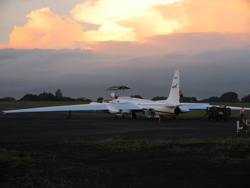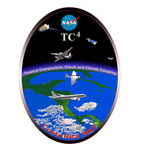
Many facets of the chemical, dynamic, and physical processes occurring in the tropical upper troposphere and tropopause transitional layer were not well understood. Identifying the key processes in this region was essential for progress on issues involving global climate change, stratospheric ozone depletion, and global tropospheric chemistry.

ER-2 before morning take off - 5 Aug. 2007
Photo Credit: Dave Simmons
 The NASA TC4 (Tropical Composition, Cloud and Climate Coupling) mission investigated the structure, properties and processes in the tropical Eastern Pacific. A-train satellite observations provided crucial information on the spatial and temporal variations of this region; however, carefully planned TC4 aircraft observations were required both to validate satellite data and to provide critical observations not available from the satellites. High altitude aircraft collected tropopause data while the medium altitude aircraft provided profiles and structure measurements of the tropical upper troposphere and lower stratosphere.
The NASA TC4 (Tropical Composition, Cloud and Climate Coupling) mission investigated the structure, properties and processes in the tropical Eastern Pacific. A-train satellite observations provided crucial information on the spatial and temporal variations of this region; however, carefully planned TC4 aircraft observations were required both to validate satellite data and to provide critical observations not available from the satellites. High altitude aircraft collected tropopause data while the medium altitude aircraft provided profiles and structure measurements of the tropical upper troposphere and lower stratosphere.
TC4 was sponsored by the NASA Headquarters Atmospheric Composition Focus Area including the Upper Atmospheric Research Program (Michael Kurlyo, Program Manager), the Radiation Science Program (Hal Maring, Program Manager) and the Tropospheric Chemistry Program (Jim Crawford, Program Manager). TC4 was based in San Jose, Costa Rica during July 2007.
The Real Time Mission Monitor provided simultaneous aircraft status for three aircraft during the TC4 experiment. During TC4, the NASA ER-2, WB-57 and DC-8 aircraft flew missions at various times. The science flights were scheduled between 17 July and 8 August 2007 and exact schedule decided on a day-to-day basis.
DOI:
https://dx.doi.org/10.5067/TC4/AMPR/DATA101






